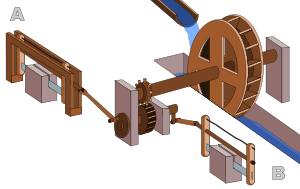- Serrería de Hierápolis
-
 Doble sierra de piedra romana movida por rueda hidráulica de Hierápolis. Del siglo III de la Era Cristiana, es la muestra más antigua del mecanismo biela-manivela.[1]
Doble sierra de piedra romana movida por rueda hidráulica de Hierápolis. Del siglo III de la Era Cristiana, es la muestra más antigua del mecanismo biela-manivela.[1]
La Serrería de Hierápolis, en Asia Menor, constaba de una doble sierra de piedra movida por una rueda hidráulica. Esta muestra de la tecnología del periodo romano funcionaba en el siglo tercero de la Era Cristiana y es la muestra más antigua del mecanismo biela-manivela.[1] Otras sierras de piedra mecánicas de la época tardo-romana (siglo VI) han sido descubiertas en los últimos años en Gerasa, Jordania,[2] y Éfeso, Turquía.[3] Posiblemente, había una cuarta del siglo II en Augusta Raurica, Suiza.[4]
Contenido
Notas
- ↑ a b Grewe, 2010; Ritti, Grewe y Kessener, 2007, p. 161; Grewe, 2009, p. 429
- ↑ Seigne, 2002a; Seigne, 2002b; Seigne, 2002c
- ↑ Mangartz, 2010
- ↑ Schiöler, 2009
Bibliografía
- Serrería romana de Hierápolis
- Grewe, Klaus (2010), «La máquina romana de serrar piedras. La representación en bajorrelieve de una sierra de piedras de la antigüedad, en Hierápolis de Frigia y su relevancia para la historia técnica (traducción al castellano: Miguel Ordóñez)», Las técnicas y las construcciones de la Ingeniería Romana, V Congreso de las Obras Públicas Romanas, pp. 381–401, http://www.traianvs.net/pdfs/2010_15_grewe.pdf
- Grewe, Klaus (2009), «Die Reliefdarstellung einer antiken Steinsägemaschine aus Hierapolis in Phrygien und ihre Bedeutung für die Technikgeschichte. Internationale Konferenz 13.−16. Juni 2007 in Istanbul», en Bachmann, Martin (en alemán), Bautechnik im antiken und vorantiken Kleinasien, Byzas, 9, Istanbul: Ege Yayınları/Zero Prod. Ltd., pp. 429–454, ISBN 978-975-807-223-1, http://www.freundeskreis-roemerkanal.de/Text/BAUTECHNIK%20IM%20ANTIKEN%20UND.pdf
- Ritti, Tullia; Grewe, Klaus; Kessener, Paul (2007), «A Relief of a Water-powered Stone Saw Mill on a Sarcophagus at Hierapolis and its Implications» (en inglés), Journal of Roman Archaeology 20: 138–163
- Serrería romana de Gerasa
- Seigne, J. (2002a), «Une scierie mécanique au VIe siècle» (en francés), Archéologia 385: 36–37
- Seigne, J. (2002b), «Sixth-Century Waterpowered Sawmill» (en inglés), Journal of the International Society of Molinology 64: 14–16
- Seigne, J. (2002c), «A Sixth Century Water-powered Sawmill at Jerash» (en inglés), Annual of the Department of Antiquities of Jordan 26: 205–213
- Serrería romana de Éfeso
- Mangartz, Fritz (2010) (en alemán), Die byzantinische Steinsäge von Ephesos. Baubefund, Rekonstruktion, Architekturteile, Monographs of the RGZM, 86, Mainz: Römisch-Germanisches Zentralmuseum, ISBN 978-3-88467-149-8
- Serrería romana hipotetíca de Augusta Raurica
- Schiöler, Thorkild (2009), «Die Kurbelwelle von Augst und die römische Steinsägemühle» (en alemán), Helvetia Archaeologica 40 (159/160): 113–124
Para saber más
- Seigne, J. (2006), «Water-powered Stone Saws in Late Antiquity. The Precondition for Industrialisation?», en Wiplinger, G. (en inglés), Cura Aquarum in Ephesos. Proceedings of the 12th Int. Congress on the History of Water Management and Hydraulic Engineering in the Mediterranean Region, Ephesus/Selçuk, Turkey, October 2-10, 2004, Vol. 1, Babesch suppl. 12, Leiden: Peeters, pp. 383–390, ISBN 978-90-429-1829-0
- Wikander, Örjan (2000), «Industrial Applications of Water-Power», en Wikander, Örjan (en inglés), Handbook of Ancient Water Technology, Technology and Change in History, 2, Leiden: Brill, pp. 401–412, ISBN 90-04-11123-9
- Wikander, Örjan (2008), «Sources of Energy and Exploitation of Power», en Oleson, John Peter (en inglés), The Oxford Handbook of Engineering and Technology in the Classical World, New York: Oxford University Press, pp. 136–157, ISBN 978-0-19-518731-1
Enlaces externos
 Wikimedia Commons alberga contenido multimedia sobre Molinos romanos. Commons
Wikimedia Commons alberga contenido multimedia sobre Molinos romanos. Commons- Traianus – El Portal Europeo de Ingeniería Romana para descargar el artículo de Klaus Grewe "La máquina de serrar piedras" se necesita registrarse por gratuito
- Reconstrucción de la serrería hídraulica de Éfeso (imágenes, videoclips, simulación 3D) (alemán)
- Este artículo fue creado a partir de la traducción parcial del artículo Sägemühle von Hierapolis de la Wikipedia en alemán, concretamente de esta versión, bajo licencia Creative Commons Atribución Compartir Igual 3.0 y GFDL.
Categorías:- Molinos
- Arquitectura romana
Wikimedia foundation. 2010.
